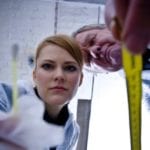 Politics
Politics  Politics
Politics  Weird Stuff
Weird Stuff 10 Eggs-traordinarily Odd Eggs
 History
History 10 Desperate Last Stands That Ended in Victory
 Animals
Animals Ten Times It Rained Animals (Yes, Animals)
 Mysteries
Mysteries 10 Devastating Missing Child Cases That Remain Unsolved
 Creepy
Creepy 10 Scary Tales from the Middle Ages That’ll Keep You up at Night
 Humans
Humans 10 One-of-a-kind People the World Said Goodbye to in July 2024
 Movies and TV
Movies and TV 10 Holiday Movies Released at Odd Times of the Year
 Politics
Politics 10 Countries Where Religion and Politics Are Inseparable
 Weird Stuff
Weird Stuff 10 Freaky Times When Famous Body Parts Were Stolen
 Politics
Politics The 10 Most Bizarre Presidential Elections in Human History
 Weird Stuff
Weird Stuff 10 Eggs-traordinarily Odd Eggs
 History
History 10 Desperate Last Stands That Ended in Victory
Who's Behind Listverse?

Jamie Frater
Head Editor
Jamie founded Listverse due to an insatiable desire to share fascinating, obscure, and bizarre facts. He has been a guest speaker on numerous national radio and television stations and is a five time published author.
More About Us Animals
Animals Ten Times It Rained Animals (Yes, Animals)
 Mysteries
Mysteries 10 Devastating Missing Child Cases That Remain Unsolved
 Creepy
Creepy 10 Scary Tales from the Middle Ages That’ll Keep You up at Night
 Humans
Humans 10 One-of-a-kind People the World Said Goodbye to in July 2024
 Movies and TV
Movies and TV 10 Holiday Movies Released at Odd Times of the Year
 Politics
Politics 10 Countries Where Religion and Politics Are Inseparable
 Weird Stuff
Weird Stuff 10 Freaky Times When Famous Body Parts Were Stolen
10 Inspiring Stories from the Fight against HIV
Living through a global pandemic, it can seem like the news has slipped into an endless cycle of misery and despair. But it is important to remember that this coronavirus is not the first epidemic humanity has faced. For the last half-century, people have been battling against the debilitating and potentially fatal terror of HIV/AIDS.
The fight is a long way from over. To date, HIV has taken over 36 million lives and still claims hundreds of thousands each year. Of the nearly 38 million people still living with the infection, one in five is said to be unaware of their condition. And with marginalized communities most at risk of infection, the virus still carries a weighty social stigma.[1]
But the fight against HIV/AIDS has also produced a wealth of uplifting breakthroughs and inspiring victories. As of January 2021, the virus has been eliminated in three patients. There are reports of a potential vaccine in the pipeline. Around the world, there are inspiring stories of people coming together to minimize HIV infection. And plenty of work is being done to fight the stigma too.
So, in these bleak times of coronavirus, when it feels like the world might be damaged beyond repair, here are ten uplifting stories from the fight against HIV/AIDS.
Related: 10 Infectious Diseases That Changed History
10 Gene Editing Helps Cure Mice
Gene editing is a controversial practice, but it could prove vital to curing HIV. In 2020, researchers discovered a way to stamp out HIV in mice.
As part of the scientists’ study, HIV-infected mice were given a cocktail of slow-release drugs for four weeks. They then received a complex gene-editing treatment. The two treatments were ineffective on their own. But the scientists found that they could eliminate HIV if they were used together. Of the 23 mice that received both therapies, nine came back HIV-negative.
Dr. Howard E Gendelman of the University of Nebraska worked closely on the study. He described it as “the first time, to my knowledge, that any group has shown viral eradication is possible in a live animal model.”
Currently, people with HIV keep relatively normal lives by taking antiretroviral drugs. These drugs stabilize the condition—but they are not a cure. If someone with HIV were to stop taking their medication, their symptoms would flare up again in only a few weeks.[2]
9 Monthly Injections Could Replace Pills
For people with HIV, taking pills is part of their daily routine. But those pills could soon be on their way out. Scientists in California have developed a monthly injection that they claim is better than pills at keeping the virus at bay. The drugs are injected into the patient’s buttock. They remain between the muscle fibers while they soak into the bloodstream. This method is remarkably effective. In a recent trial, 94% of participants who received the injection were stable after two years.
The injectable therapy is welcome news to many, including UN health expert Mahesh Mahalingam. As he told reporters, “It will help remove the challenge of taking tablets every day and significantly improve the quality of life of people living with HIV.”[3]
8 “Dusseldorf Patient” Cured after Bone Marrow Transplant
In 2019, a patient in Germany became the third person in history to be cured of HIV after receiving a bone marrow transplant. For confidentiality reasons, very little is known about the identity of the “Dusseldorf Patient.” But, when doctors revealed the case at a conference in Seattle, the patient had gone three months without taking medication and was still free of HIV. The scientists looked for traces of the virus by studying tissue from the lymph nodes and the gut.
A bone marrow transplant is an advanced treatment in which infected cells are replaced with healthy ones. Scientists have been aware of the potential of bone marrow transplants since 2007, when “Berlin Patient” Timothy Ray Brown became the first person to be cured of the virus.[4]
7 Protests Against Mbeki’s Denial in South Africa
HIV was rife in post-apartheid South Africa. By the mid-1990s, over one and half million people had tested positive for the virus. The hospitals were filled with dying patients. Across the country, tens of thousands of mothers were giving birth to infected babies.
Amidst this devastation, President Thabo Mbeki decided to push aside a wealth of scientific evidence. He declared that people with HIV should stop taking their medication. Instead, officials were recommending garlic and beetroot as potential treatments. In addition, Mbeki banned infected mothers from accessing drugs that would prevent them from passing on the virus to their children. Mbeki’s leadership is said to have cost 300,000 people their lives.
But the people of South Africa did not suffer Mbeki’s actions gladly. Throughout his presidency, protesters took to the streets. Crowds of South Africans called on the president to abandon his AIDS denial and face reality. Finally, in 2001, a community group called the Treatment Action Campaign took the issue to court. Their legal case forced the government to backtrack. Pregnant women would finally be allowed to access the medication they so desperately needed.
The impact on South Africa’s collective health has been astounding. In the decade following the drug’s release, life expectancy has risen by nine years. The child mortality rate has fallen through the floor. Mbeki resigned in 2008, making space for a government committed to tackling the pandemic. South Africa is still a long way from kicking out the virus completely. But they are in a far stronger position than they were twenty years ago.[5]
6 PrEP Prevents Infection
Prevention, the saying goes, is better than the cure. Especially with HIV/AIDS, which has no known cure. Over the past fifteen years, researchers have made incredible strides in developing the PrEP medication that they say reduces the risk of getting HIV to almost zero.
PrEP is a daily program of drugs that protect at-risk people from contracting the virus. Initially, the drugs were limited to certain groups like sex workers and people who inject drugs. But after promising trials, the World Health Organization recommended that PrEP be made available to anyone at risk of infection. The rollout of PrEP now includes countries like the U.S., Brazil, and Thailand. In Thailand, anyone can access free PrEP no matter their age or gender.[6]
5 HIV-Positive Sperm Bank Opens in New Zealand
In 2019, New Zealand opened the doors to the world’s first HIV-positive sperm bank. Sperm Positive is part of a new scheme to reduce the stigma surrounding the virus. All the men who donate to the bank will be HIV-positive with an undetectable viral load. This means that when their sperm is used for conception, there is no possibility of the virus being transmitted to the child.
Sperm Positive is a collective effort run by three charities—Positive Women Inc, Body Positive, and the New Zealand Aids Foundation. They hope that the project will help broaden people’s horizons about the virus and lessen the social shame attached to it.[7]
4 Brighton’s HIV Test Vending Machine
The English city of Brighton faces numerous issues when it comes to HIV. Excluding London, it has the highest rate of HIV in the country. Eight out of every 1,000 people have tested positive for the virus, four times the national average. A 2016 study estimated that almost one-fifth of the people with HIV in Brighton were unaware that they had the infection.
However, that number is falling. In 2016, the city council became the first in the UK to commit to a target of zero new infections.
To minimize infection, the council installed vending machines across the city so that locals could access HIV testing kits. These machines are the first of their kind anywhere in the world. In 2017, the Martin Fisher Foundation set up five machines in venues around Brighton that are often visited by high-risk groups.
The vending machines are playing a vital role in reducing Brighton’s infection rate. The Foundation recently upgraded three of them to full Sexual Health Machines. Now, locals can use the machines to get STI kits as well as HIV tests.[8]
Following Brighton’s promising example, Glasgow, Liverpool, London, and Manchester have also pledged to eradicate new infections.
3 Cyclists Help HIV-Positive Sex Workers in Zimbabwe
Coronavirus has taken its toll on all of our lives. But, for HIV-positive sex workers in rural Zimbabwe, the pandemic has been a nightmare. Zimbabwe’s national lockdown has stopped people in remote areas from accessing necessities.
When the pandemic hit, people in the village of Mashava were suddenly unable to get to the nearest clinic. This left four hundred HIV-positive sex workers stranded without their medication. Women like Dorcas Mbiri found that they were being turned away by the police and told to stay indoors.
So Mbiri and her colleagues decided to organize among themselves. They borrowed bicycles so that once a week, a cyclist could travel to the nearest clinic and collect essential medication for the villagers. On the poor quality Zimbabwean roads, the 10km trek (6.2 miles) can take almost three-quarters of an hour. But it has provided a much-needed lifeline for the sex workers of Mashava.[9]
2 Woman Free of HIV for Twelve Years without Medication
In 2015, a young woman born with HIV made headlines after testing HIV-negative twelve years after last taking her medication. The unnamed woman was treated with antiretroviral drugs as a baby. But, after six years, the family decided to end her treatment. A year later, aged seven, doctors tested her again and found no trace of the virus.
Eleven years later, now an adult, she went back for another HIV test. Medical professionals were astounded by what they saw. Remarkably, over a decade since her last dose of drugs, HIV had not resurfaced in the young woman’s blood. This was the longest any young person has gone virus-free without medication.
“There have been other reports of treating infants followed by the stoppage of antiretroviral therapy that have not turned out as well,” explained Dr. Scott Sieg, an expert in infectious disease and HIV. “This case provides new hope.”[10]
1 DNA-rTV, China’s Potential HIV Vaccine
Researchers in China have produced a potential HIV vaccine. One day, this may be used to protect the public from the virus. The potential vaccine, DNA-rTV, completed its second phase of clinical trials in 2019. So far, the results appear to be positive.
DNA-rTV is a replicating viral vector vaccine. This means that the vaccine particles can reproduce themselves. These new particles then enter cells in the body and produce antigens. Antigens are hugely important for immunization because they make the immune system produce antibodies. If that person ever becomes infected, those antibodies will play a vital role in helping the immune system fight off the virus.
Developing an HIV vaccine is a difficult task. Scientists say that we should not expect the vaccine any time soon. Jin Cong, director of China’s AIDS Prevention Office, has warned people not to get their hopes up too quickly.
“In general, all vaccines require a long process from development to the market,” Cong explained. “It is even more difficult for the AIDS vaccine, which is determined by the characteristics of the AIDS virus itself.”[11]








